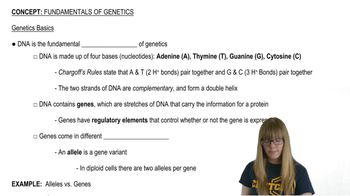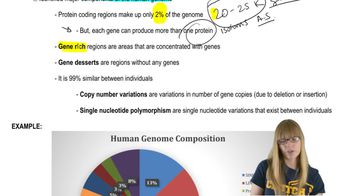Table of contents
- 1. Introduction to Genetics51m
- 2. Mendel's Laws of Inheritance3h 37m
- 3. Extensions to Mendelian Inheritance2h 41m
- 4. Genetic Mapping and Linkage2h 28m
- 5. Genetics of Bacteria and Viruses1h 21m
- 6. Chromosomal Variation1h 48m
- 7. DNA and Chromosome Structure56m
- 8. DNA Replication1h 10m
- 9. Mitosis and Meiosis1h 34m
- 10. Transcription1h 0m
- 11. Translation58m
- 12. Gene Regulation in Prokaryotes1h 19m
- 13. Gene Regulation in Eukaryotes44m
- 14. Genetic Control of Development44m
- 15. Genomes and Genomics1h 50m
- 16. Transposable Elements47m
- 17. Mutation, Repair, and Recombination1h 6m
- 18. Molecular Genetic Tools19m
- 19. Cancer Genetics29m
- 20. Quantitative Genetics1h 26m
- 21. Population Genetics50m
- 22. Evolutionary Genetics29m
7. DNA and Chromosome Structure
DNA Structure
Problem 16a
Textbook Question
Which of the following equations are true for the percentages of nucleotides in double-stranded DNA?
(A)/(G) = (T)(C)
 Verified step by step guidance
Verified step by step guidance1
Understand Chargaff's rules, which state that in double-stranded DNA, the amount of adenine (A) equals the amount of thymine (T), and the amount of guanine (G) equals the amount of cytosine (C). This can be expressed as A = T and G = C.
Recognize that Chargaff's rules imply that the ratio of A to T and G to C should be 1:1 in double-stranded DNA.
Analyze the given equation (A)/(G) = (T)(C). According to Chargaff's rules, A = T and G = C, so the equation should reflect these equalities.
Substitute the known equalities from Chargaff's rules into the equation: since A = T and G = C, the equation becomes (A)/(G) = (A)(G).
Evaluate whether the transformed equation (A)/(G) = (A)(G) holds true under the conditions of Chargaff's rules, considering the relationships between the nucleotide pairs.
 Verified video answer for a similar problem:
Verified video answer for a similar problem:This video solution was recommended by our tutors as helpful for the problem above
Video duration:
4mPlay a video:
Was this helpful?
Key Concepts
Here are the essential concepts you must grasp in order to answer the question correctly.
Chargaff's Rules
Chargaff's Rules state that in double-stranded DNA, the amount of adenine (A) equals thymine (T), and the amount of guanine (G) equals cytosine (C). This means that A pairs with T and G pairs with C, leading to a specific ratio of nucleotides that is crucial for understanding DNA structure and function.
Recommended video:
Guided course

Genetics Basics
Base Pairing
Base pairing refers to the specific hydrogen bonding between nucleotide bases in DNA. Adenine pairs with thymine (A-T) and guanine pairs with cytosine (G-C). This complementary pairing is fundamental to the double-helix structure of DNA and ensures accurate replication and transcription processes.
Recommended video:
Guided course

Base Distortions
Nucleotide Composition
Nucleotide composition in DNA refers to the relative amounts of the four nucleotides: adenine, thymine, guanine, and cytosine. Understanding the composition is essential for analyzing genetic information and can reveal insights into evolutionary relationships and genetic disorders based on variations in nucleotide ratios.
Recommended video:
Guided course

Human Genome Composition
Related Videos
Related Practice




